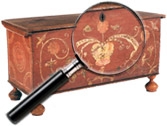|
|
Clementine Hunter (1887 to 1988)
Clementine Hunter (pronounced Clementeen) was born to Creole parents, Antoinette Adams and Janvier Reuben, in late December of 1886 or early January of 1887 at Hidden Hill Plantation near Cloutierville, Louisiana. Hunter would never learn to read or write, later saying she only had about ten days of schooling, and was put to work in the fields when she was very young. At 15, she left Hidden Hill, which [...] Click here to continue reading.
Cartouche – Definition
The decorative arts world has many “squishy” and vague vocabulary words, but few are “squishier” and vaguer than cartouche. Originally, the term comes from Egyptology and is used to describe a oval enclosing hieroglyphics and having a horizontal line at one end. (The line denotes royalty.) The oval had significance not unlike that of a closed circle, in that it was believed that an oval around a person’s name provided protection [...] Click here to continue reading.
Jacquard Coverlets
Joseph Marie Charles (1752-1834) never really bore the surname that has been applied to his loom. Rather Jacquard was a nickname of sorts given to his family’s particular branch of all the Charleses in Lyon during the 18th century. Despite the family’s prosperity (his father was a master weaver), Joseph had very little education and did not learn to read until he was a teenager. Joseph’s father died when Joseph was 20, [...] Click here to continue reading.
Estate of Peter L. Rosenberg of Vallin Galleries, Wilton Connecticut
Discerning collectors, dealers, and museum curators of Asian art regularly made pilgrimages to a charming 18th century saltbox home in Wilton, Connecticut: Vallin Galleries. Owned and operated by Peter L. Rosenberg for nearly thirty years until his sudden death in December of 2013, Vallin Galleries was widely regarded as an outstanding source for the best of Asian art and antiques. Skinner is proud to [...] Click here to continue reading.
Zoar
In the 1810s, a group of German religious separatists left Wurttemberg in what is now southwestern Germany, after several decades of separation from the primary church in the region, the Lutheran Church. After years of persecution and oppression which included imprisonment and property seizures, the separatists, under the leadership of Joseph Bimeler (sometimes Baumeler), decided to flee to the United States in the hopes that they could establish a new community there.
One [...] Click here to continue reading.
Collection of Florence P. and William W. Griffin
Bill and Florence Griffin met at an Atlanta Bird Club meeting in 1945. Bill was a published amateur ornithologist; Florence was interested in all of nature – she knew the names of all the plants as well as the birds.
Both were from Georgia, and soon began to see their state changing before their eyes as the New South swept away the Old. They quickly became [...] Click here to continue reading.
Bakelite
Scandal & the Story of Bakelite Bakelite hit the market in 1907, heralding the arrival of the modern plastics industry. Bakelite was the first completely man made plastic, as until then, plastics such as celluloid, casein, and Gutta-Percha all had as a base a natural material. It was developed by Belgian-born chemist Dr. Leo Hendrick Baekeland who started his firm General Bakelite Company to produce the phenolic resin type plastic. Bakelite was inexpensive [...] Click here to continue reading.
Ormolu
Ormolu, an 18th-century English term, is from the French phrase or moulu, with “or” indicating gold and “moulu” being a form of an old French verb moudre, which means “to grind up.” (This French term for this technique is bronze dore.) This idea of “ground-up gold”refers to the production process of ormolu, where high-quality gold is finely powdered and added to a mercury mixture and applied to a bronze object. Modern usage often [...] Click here to continue reading.
Tagua Nuts
Tagua nuts are the endosperm of a genus of South American palm trees that are found from Panama down through Bolivia and Peru. Tagua nuts, or more accurately, the kernels of tagua seeds, are left behind by the wildlife that feed on the palm’s fruit. The group of palms is often referred to as “tagua palms” or “ivory-nut palms,” because tagua nuts are so hard, they resemble elephant ivory. (In fact, the [...] Click here to continue reading.
Sitting Bull, Sioux Chief (circa 1831 to 1890)
Sitting Bull, the man who would later become the Hunkpapa Sioux chief, was born in South Dakota, near the Grand River. His Lakota name was Tatanka-Iyotanka. In his thirties, he began to build his reputation as a warrior, leading war parties in Red Cloud’s War against a number of Dakota Territory forts. Although the U.S. negotiated with the Sioux in order to end the war and [...] Click here to continue reading.
|
Recent Articles
- Charles Alfred Meurer – American Artist & Tromp L’Oeil Artist
- Sendak, Maurice – American Artist & Writer
- Godie, Lee – American Artist
- Davis, Vestie – American Artist
- Bartlett, Morton – American Artist
- Mackintosh, Dwight – American Artist
- Evans, Minnie Jones – African-American Artist
- Mumma, Ed (Mr. Eddy) – American Artist
- Nice, Don – American Artist
- Savitsky, John (Jack) – American Artist
- Gordon, Harold Theodore (Ted) – American Artist
- Dial, Thornton – African-American Artist
- Doyle Sam – American Artist
- Johnson, Lester Frederick – American Artist
- Finster, Howard – American Artist
|
|
